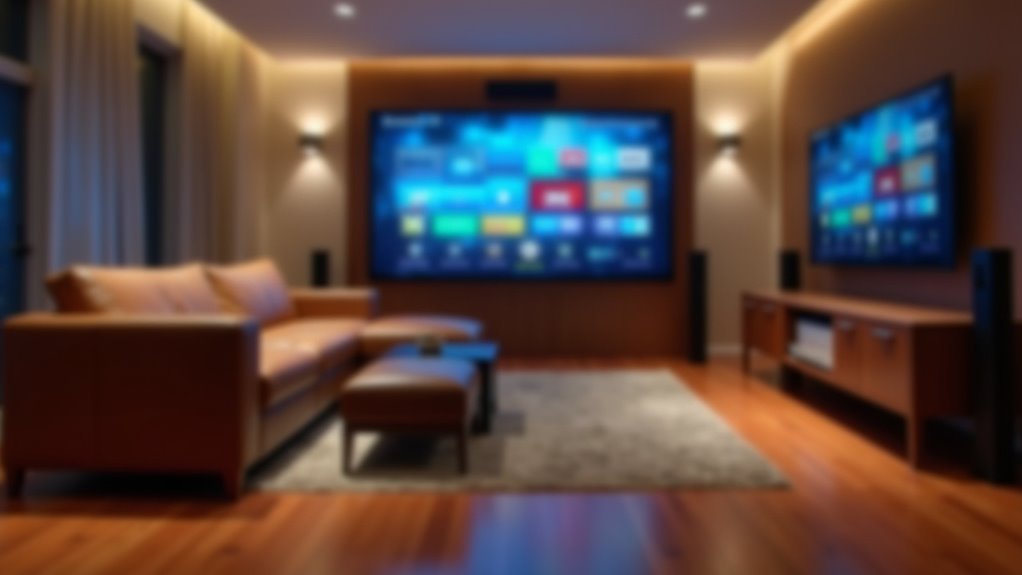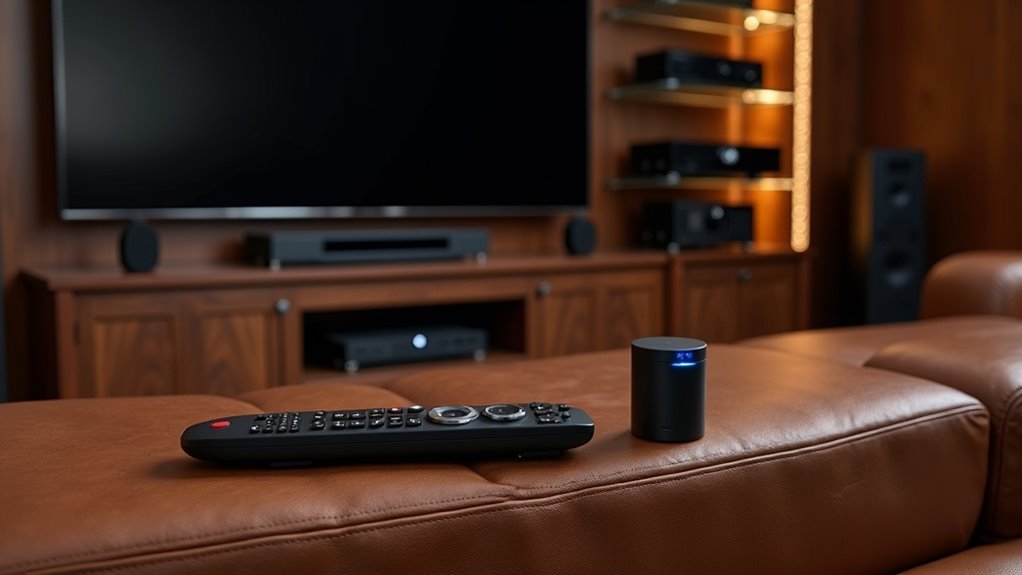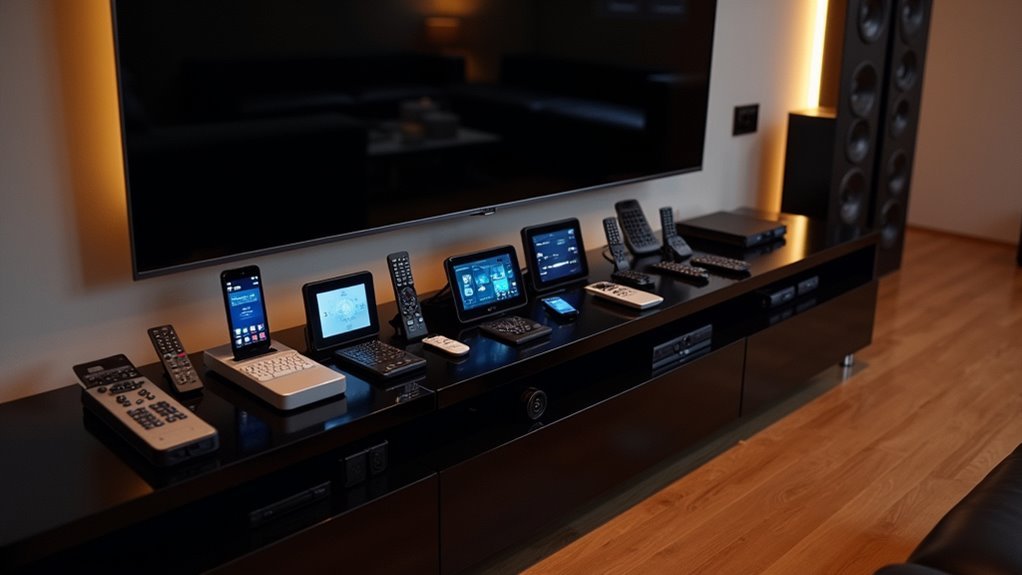You’re standing in your entertainment room, fumbling through multiple remotes just to watch a movie. There’s got to be a better way to control your projector, sound system, lighting, and streaming devices without the chaos. The right home theater control system can transform this frustrating experience into seamless automation with a single touch. But with so many options promising different features and price points, choosing the perfect system requires understanding what each one actually delivers.
Control4: Industry-Leading Smart Home Integration Platform

The sophistication of modern home entertainment demands a control system that can unify countless devices into one cohesive experience. Control4 stands as an industry leader in smart home integration, delivering seamless connectivity across your entire entertainment ecosystem.
Control4 transforms complex entertainment setups into unified, seamless experiences that adapt to your sophisticated smart home needs.
You’ll appreciate how this platform transforms complex setups into streamlined experiences through its intuitive interface that welcomes users of all technical backgrounds.
What sets Control4 apart among control systems is its customizable automation capabilities. You can create personalized scenes that simultaneously adjust lighting, audio, and video with single commands tailored to your specific activities.
The system’s scalability guarantees your setup grows with evolving needs, while extensive compatibility with third-party brands like Sonos, Philips Hue, and Nest assures seamless integration throughout your smart home environment.
Crestron: Professional-Grade Automation for Premium Experiences
When serious home theater enthusiasts demand uncompromising control over their entertainment systems, Crestron delivers professional-grade automation that exceeds even the highest expectations.
You’ll experience unparalleled customization through advanced programming capabilities that transform your space into a truly personalized entertainment environment.
The system’s extensive communication protocols—including IR, RS-232, and Ethernet—guarantee seamless integration with all your audio and video components.
You can create sophisticated scenes that simultaneously dim lights, adjust sound levels, and power up devices with a single command.
Crestron’s intuitive touch-screen interface makes maneuvering through complex settings effortless, while the system’s scalability accommodates future upgrades without compromising performance.
This professional-grade automation platform assures your home theater remains cutting-edge as your entertainment needs evolve.
Savant: Elegant Design With Voice Control Capabilities

Since luxury and functionality rarely converge so seamlessly, Savant’s home theater control systems stand out by delivering sophisticated automation wrapped in stunning visual design.
You’ll appreciate how this platform transforms your entertainment space with its elegant aesthetic that complements any home theater environment.
The system’s robust voice control capabilities let you operate your entire setup effortlessly through simple spoken commands, eliminating the need for multiple remotes.
You can customize the user interface to match your preferences, creating an intuitive navigation experience that feels natural.
Savant integrates with diverse devices and services, giving you thorough control over lighting, audio, and video components from one interface.
The scalable design guarantees you’ll easily expand your system as new technologies emerge.
RTI: Budget-Friendly Remote Control Solutions
You’ll find RTI’s remote control solutions offer an impressive combination of advanced programming capabilities without the premium price tag that typically comes with high-end systems.
The setup process is invigoratingly straightforward, allowing you to configure your entire home theater system through intuitive software that doesn’t require extensive technical expertise.
You can customize button layouts, create personalized activities, and integrate multiple components while staying within a reasonable budget that makes professional-grade control accessible to most homeowners.
Affordable Programming Features
Although premium home theater control systems can cost thousands of dollars, RTI’s budget-friendly remote control solutions deliver robust programming features that won’t strain your wallet.
You’ll access powerful customization tools that typically come with expensive systems, making professional-grade control affordable for any homeowner.
RTI’s affordable programming features include:
- One-Touch Macros – You can program complex sequences that automatically switch between entertainment modes like movies, gaming, or music with a single button press.
- Multi-Device Integration – You’ll control various audio-visual components through one interface, eliminating the need for multiple remotes cluttering your coffee table.
- User-Friendly Interface – Whether you’re tech-savvy or technology-challenged, you’ll navigate RTI’s intuitive programming system without requiring expensive professional installation services.
Easy Setup Process
Beyond these powerful programming capabilities, RTI simplifies the entire setup experience so you can start enjoying your customized home theater control within minutes. The easy setup process eliminates technical barriers that typically frustrate users during installation.
You’ll find RTI’s intuitive configuration tools guide you through device pairing and system integration without requiring professional assistance. The streamlined user experience means you won’t struggle with complex programming languages or confusing menus.
RTI’s interface walks you through each step, automatically detecting compatible devices and suggesting ideal settings. You can quickly map functions to hard buttons and customize layouts according to your preferences.
This straightforward approach guarantees your family members can immediately operate the system without extensive training, making RTI’s budget-friendly solution both accessible and practical for everyday use.
Harmony Elite: Universal Remote With Wireless Hub Functionality

You’ll find that the Harmony Elite’s wireless hub creates a centralized control system that eliminates the need for direct line-of-sight communication with your devices.
The hub’s wireless functionality lets you control equipment hidden in cabinets or other rooms while maintaining reliable connectivity throughout your home theater setup.
Programming custom macros becomes straightforward with the hub’s ability to sequence multiple device commands, allowing you to automate complex entertainment scenarios with single button presses.
Wireless Hub Benefits
When you’re managing a complex home theater setup, the Harmony Elite’s wireless hub transforms how you control your entertainment ecosystem.
This wireless hub eliminates line-of-sight limitations, letting you operate devices from any room in your house. You’ll appreciate the seamless connectivity through multiple communication protocols.
The wireless hub delivers three key advantages:
- Multi-protocol communication – Controls devices via Wi-Fi, IR, and Bluetooth for maximum compatibility
- One-touch automation – Execute complex command sequences with single button presses
- Smartphone integration – Use the Harmony app’s visual interface from anywhere in your home
You can create customized “Activities” that automate entire sequences, like simultaneously turning on your TV, dimming smart lights, and starting your sound system.
This streamlines your entertainment experience while reducing remote clutter.
Programming and Macros
Programming your Harmony Elite becomes surprisingly straightforward thanks to its companion app that walks you through each step of device setup and macro creation. You’ll find the programming process intuitive, allowing you to establish customized “Activities” that simultaneously power on multiple devices and adjust settings with one button press.
| Activity Type | Devices Controlled | Example Action |
|---|---|---|
| Movie Night | TV, Receiver, Blu-ray | Powers on all devices, switches inputs |
| Gaming Session | TV, Console, Sound System | Activates gaming mode, adjusts audio |
| Music Time | Receiver, Streaming Device | Launches music app, sets volume |
| Bedtime | All Entertainment Devices | Powers everything off sequentially |
The touchscreen interface displays your programmed activities clearly, making complex home theater operations feel effortless and accessible.
Q-Nex NMP: Centralized Control With Customizable Interfaces
As home theater systems become increasingly complex with multiple components and devices, the Q-NEX NMP emerges as a powerful solution that consolidates control into a single, intuitive platform.
This centralized control system eliminates the frustration of juggling multiple remotes while providing seamless operation across all your AV equipment.
The Q-NEX NMP’s customizable interfaces adapt to your family’s preferences, making complex technology accessible to everyone.
You’ll appreciate these key advantages:
- Device Integration – Compatible with existing theater equipment and smart home systems
- Scalable Design – Easily expand your setup as technology evolves
- Automated Scenes – Program custom sequences that enhance your viewing experience
With advanced programming capabilities, you can create personalized entertainment environments that respond to your specific needs, transforming how you interact with your home theater system.
Lutron: Comprehensive Lighting and Shade Control Systems
You’ll find Lutron’s lighting control systems transform your home theater experience through seamless smart lighting integration that works with popular AV systems like Control4 and Crestron.
Their Caséta Wireless and RadioRA 3 systems let you control both lighting and motorized shades from your smartphone or voice assistants like Alexa and Google Assistant.
This all-encompassing approach creates fully automated environments where you can set specific lighting and shading scenes for movie nights with just one command.
Smart Lighting Integration
When designing the perfect home theater environment, Lutron’s extensive lighting and shade control systems deliver unmatched precision and convenience for creating immersive viewing experiences.
You’ll appreciate how seamlessly these systems integrate with your smart home setup, automatically adjusting lighting scenes based on your specific activities.
Your theater’s lighting responds intelligently through three key functions:
- Automatic dimming – Overhead lights fade while accent lighting adjusts when movies begin
- Smart shade control – Blinds automatically close based on time of day or user preferences
- Unified system integration – Single commands simultaneously control lighting, sound, and video
You’re investing in reliable, scalable technology that grows with your evolving home theater needs.
Lutron’s all-encompassing approach transforms ordinary rooms into professional-grade entertainment spaces.
Automated Shade Control
Beyond smart lighting adjustments, Lutron’s automated shade control systems provide the finishing touch for your home theater’s light management strategy.
You’ll achieve ideal viewing conditions by scheduling shades to close automatically during movie times or adjust throughout the day based on natural light levels. These systems integrate seamlessly with your existing theater setup, synchronizing with lighting controls to create perfect ambient scenes at the touch of a button.
You can customize shade styles and materials to match your décor while ensuring effective light blockage and privacy.
Control everything through mobile apps or smart home devices from anywhere in your house. The automated shade control responds instantly to predefined scenes, eliminating manual adjustments and delivering consistent, professional-quality lighting for every viewing experience.
Tablet-Based Control Systems for Touch Screen Navigation
While smartphone apps offer convenient control options, tablet-based control systems deliver a superior home theater control experience through their larger, more intuitive touch interfaces.
You’ll appreciate the clear visibility and enhanced usability that comes with dedicated tablet devices, which eliminate distractions from other applications while you’re managing your entertainment setup.
These systems provide three key advantages:
- Quick access to settings – Navigate through configurations with responsive touch controls
- Customizable interfaces – Tailor layouts to match your specific activities and preferences
- Seamless integration – Connect with popular AV systems like Control4 and Savant
You’ll find that well-designed tablet interfaces with clear labeling make controlling complex home theater environments feel effortless and intuitive.
DIY IR Extender Networks for Multi-Room Management
Three fundamental components make DIY IR extender networks the backbone of efficient multi-room home theater management.
You’ll need a receiver to capture signals from your remote control, an emitter to transmit those signals to target devices, and proper planning to avoid interference.
Creating your network starts with mapping device locations across rooms. You can choose wired or wireless configurations depending on your home’s layout and installation preferences.
Connect receivers in your primary viewing area and position emitters near projectors, receivers, and streaming devices in other rooms.
Testing becomes critical for reliable operation. You’ll want to verify signal strength and eliminate interference from other electronics.
This setup lets you consolidate multi remotes into a centralized control system, providing seamless management of your entire home theater ecosystem.
Scene Programming and Automated Lighting Integration
Scene programming transforms your home theater from a collection of individual components into a synchronized entertainment ecosystem.
With a single command, you’ll automate multiple actions that previously required manual adjustments, streamlining shifts between different activities like movie nights, gaming sessions, or parties.
Your automated lighting integration becomes particularly powerful when programmed to create ideal viewing environments.
Scene programming can:
- Dim overhead lights and adjust sconces automatically when starting a movie
- Create customized experiences like “family movie night” with specific lighting and audio levels
- Include thorough automation that controls shades, temperature, and environmental settings
Collaborating with A/V integrators guarantees your scene programming aligns with your specific preferences.
This tailored approach enhances functionality while creating a fully integrated experience that goes beyond basic lighting and audio control.
Frequently Asked Questions
How Much Should I Budget for a Complete Home Theater Control System?
You’ll typically spend $500-$3,000 for a complete home theater control system. Basic universal remotes cost $100-$500, while professional smart home automation systems range $1,500-$3,000, depending on your equipment complexity and installation requirements.
Can I Install a Home Theater Control System Myself or Need Professional Help?
You can install basic systems yourself if you’re tech-savvy, but complex multi-room setups with custom programming typically require professional installation to guarantee proper integration, calibration, and avoid costly mistakes.
Will My Existing Entertainment Devices Work With New Control Systems?
Your existing entertainment devices will likely work with new control systems through IR, WiFi, or Bluetooth connections. You’ll need to check compatibility specs, but most modern control systems support popular brands and older equipment.
How Do I Troubleshoot Connectivity Issues Between Control System and Devices?
Check your network connections first, then restart both devices. Verify you’re using correct IR codes or IP addresses. Update firmware on all components. Test each device individually, then systematically add them back.
What Happens if My Control System Manufacturer Stops Supporting My Model?
You’ll face discontinued software updates, potential security vulnerabilities, and limited technical support. Consider upgrading to newer models, switching manufacturers, or using third-party solutions to maintain functionality and compatibility with modern devices.





Leave a Reply